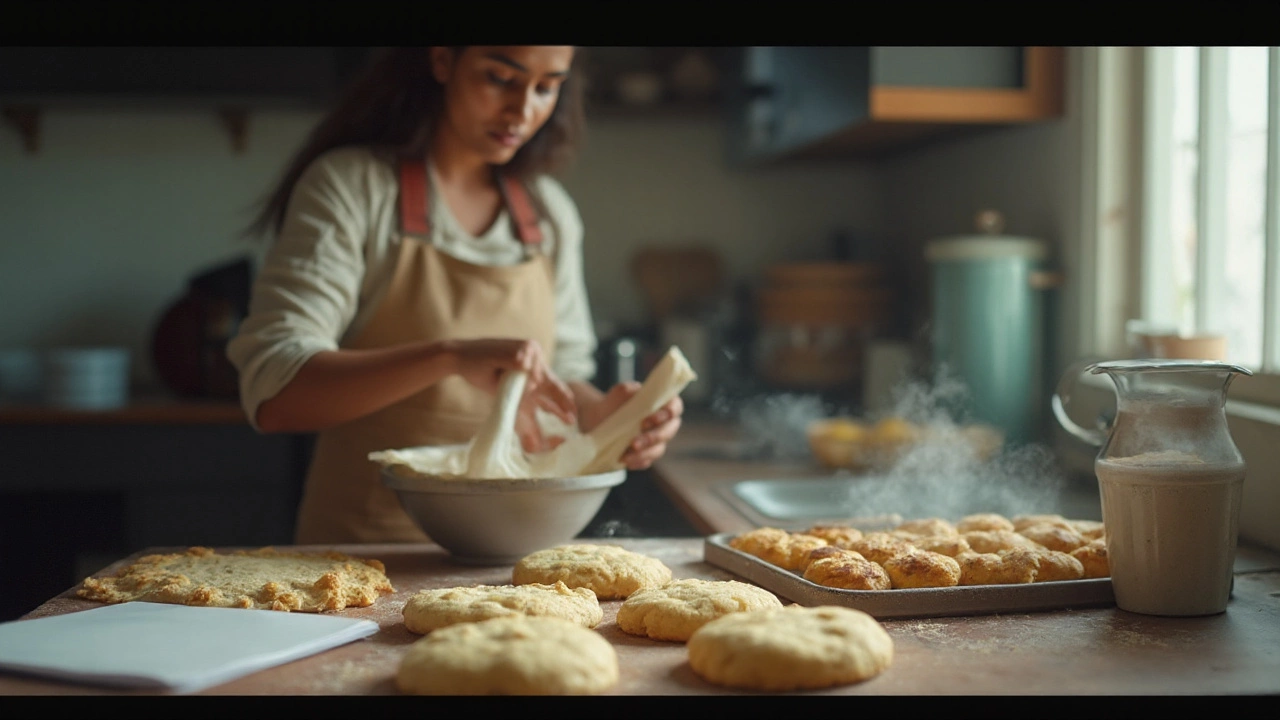You can stop blaming your oven. The trick to gluten-free baking isn’t a single hack-it’s three levers you pull together: the right flour blend for structure, a binder to replace gluten, and enough hydration plus rest so the batter actually drinks. Get those right and even a basic banana bread will slice cleanly and stay tender for days.
TL;DR: What actually makes gluten-free bakes work
Here’s the short version-so you can get mixing without wading through jargon:
- Use a blend, not one flour. Aim for a balance: whole-grain flours for body + rice flour for neutrality + starch for tenderness.
- Add a binder. Xanthan or psyllium replaces gluten’s elasticity. Start small: 0.25-0.5% of flour weight for cakes/cookies; 1-2% for breads.
- Hydrate more than wheat recipes. Most gluten-free batters need ~10-25% extra liquid. Then rest 20-45 minutes so flours fully absorb.
- Mix thoroughly (don’t fear a bit of overmixing). Without gluten, you won’t make things tough-proper mixing improves crumb.
- Bake hot and fast to set structure. Preheat properly, use light-coloured pans, and check internal temps (cakes ~98°C, bread ~96-98°C).
In Australia, note: oats aren’t considered gluten-free under the Food Standards Code. If you’re coeliac, skip oats and look for Coeliac Australia-endorsed products. Wheat starch products must be labelled according to the Code (cite: Coeliac Australia; FSANZ).
Step-by-step: The method that fixes 80% of failures
Think of this as your base playbook. Follow it, then tweak to taste.
-
Choose or mix a sensible flour blend. If you’re using a store blend (e.g., Orgran, White Wings, Well & Good, Bob’s Red Mill 1:1), check if it already contains xanthan or raising agents. If it does, reduce any extra gums or leaveners you add.
DIY basic blend (by weight): 40% whole-grain flour (sorghum or buckwheat) + 30% rice flour (white or brown) + 30% starch (tapioca or potato; up to half can be cornflour). This ratio gives flavour, structure, and tenderness without gumminess.
-
Add the right binder for the job.
- Xanthan gum: 1/4 tsp per 150 g flour for cookies; 1/2-3/4 tsp per 150 g for cakes/muffins; 1-1.5 tsp per 300 g for sandwich bread.
- Psyllium husk (powdered): 1-2% of flour weight for breads (3-6 g per 300 g flour). Gives bouncy crumb and good slicing. Husk flakes are less potent-use about double.
- Eggs, chia, flax: Good for moisture and light binding. Chia/flax gels: 1 tbsp ground + 3 tbsp water = 1 egg, let gel 10 minutes.
Evidence check: Research in Food Hydrocolloids and Cereal Chemistry shows xanthan and psyllium increase gas retention and crumb elasticity in gluten-free doughs, improving volume and softness. You don’t need much-too much turns gummy.
-
Increase hydration and rest the batter. Gluten-free flours are thirsty-especially sorghum, buckwheat, and brown rice. Add 10-25% more liquid than your wheat recipe, then rest:
- Cookies: 15-30 minutes (or chill 1 hour).
- Cakes/muffins: 20-30 minutes.
- Yeast breads: 30-45 minutes before shaping; another 20-30 minutes after.
In Melbourne’s dry winter or on windy days, you may need a splash more liquid. In humid summer, hold back 1-2 tbsp and add as needed.
-
Mix with intent. Without gluten, you can beat longer to smooth grittiness. Cream sugar and fat well for aeration. For breads, treat it like a thick batter-beat 3-5 minutes to activate binders.
-
Control heat. Preheat fully. Use 170-180°C for cakes and 200-230°C for bread, depending on style. Bake until the centre hits temperature (instant-read thermometers are worth it). Tent with foil if browning too fast.
-
Cool, then slice. Structure finishes setting as it cools. If you slice hot, you’ll think it’s gummy. Wait 30-60 minutes for cakes; 2 hours for loaves.

Examples and conversions that actually work
Below are proven templates you can plug into your favourite flavours. All weights use metric cups (Australia: 250 ml), but rely on grams for accuracy.
1) Soft muffins (12 standard)
- Flour blend: 240 g (96 g sorghum, 72 g white rice flour, 72 g tapioca starch)
- Sugar: 150-180 g (to taste)
- Baking powder: 2.5 tsp (reduce to 2 tsp if using self-raising GF flour)
- Baking soda: 1/4 tsp (especially helpful with acidic add-ins like yoghurt or berries)
- Salt: 1/2 tsp
- Eggs: 2 large (or 2 chia eggs)
- Milk of choice: 240-270 ml (start at 240; add up to 30 ml if batter looks stiff)
- Oil or melted butter: 90 ml
- Vanilla: 2 tsp
- Xanthan: 1/2 tsp (or 1 tsp psyllium powder)
- Whisk dry ingredients; mix wet; combine and beat 1 minute until smooth.
- Rest 20-25 minutes; batter should mound and slowly relax.
- Bake 180°C, 18-22 minutes, until tops spring back and centre is ~98°C.
2) Everyday sandwich bread (1 loaf tin, 21×11 cm)
- Flour blend: 300 g (120 g buckwheat or sorghum, 90 g white rice, 90 g potato or tapioca starch)
- Instant yeast: 2 tsp
- Sugar or honey: 20 g
- Salt: 1.25 tsp
- Warm water or milk: 360-400 ml (start at 360; add to thick milkshake consistency)
- Oil: 2 tbsp
- Egg whites: 2 (optional, improves rise), or 1 whole egg
- Psyllium husk powder: 6 g (about 2 tsp) or xanthan 1-1.5 tsp
- Beat all ingredients 3-5 minutes until glossy and stretchy.
- Rest 30 minutes; scrape into lined tin; smooth top with wet spatula.
- Proof 20-35 minutes until risen 1-2 cm above rim (don’t overproof).
- Bake 210°C for 45-55 minutes; internal temp 96-98°C. Cool fully before slicing.
3) Chewy chocolate chip cookies (18-20 cookies)
- Flour blend: 210 g (105 g brown rice, 42 g sorghum, 63 g tapioca)
- Butter: 170 g, browned and cooled
- Brown sugar: 150 g; white sugar: 80 g
- Egg: 1 + 1 yolk
- Salt: 1/2 tsp; vanilla: 2 tsp
- Baking soda: 1/2 tsp
- Xanthan: 1/4 tsp
- Chocolate: 200 g chopped
- Whisk dry; mix wet; combine and beat 1 minute.
- Rest 30 minutes or chill 1 hour. Scoop, then bake 170°C for 10-12 minutes.
- Tap tray mid-bake for crinkles; cool on tray 10 minutes to set edges.
Converting a wheat recipe you love
- Flour: Replace 100% by weight with your blend.
- Liquid: Add 10-25% more (start at 10%).
- Binders: Add xanthan (0.25-0.5% for cakes, 0.8-1% for bread) or psyllium (1-2% for bread).
- Time: Rest 20-45 minutes before baking.
- Leaveners: Keep the same, unless your blend already has raising agents (Australian self-raising blends-reduce baking powder by 25-40%).
Cheat sheets, ratios, and a handy flour table
Bookmark this section. It’s the stuff you’ll check before every bake.
Quick ratios (by flour weight)
- Cakes/muffins: 40% whole-grain + 30% rice + 30% starch. Xanthan 0.3-0.5%. Hydration roughly 80-95% of flour weight.
- Cookies: 60% rice + 40% starch or 50/30/20 (rice/starch/whole). Xanthan 0.15-0.3%. Rest or chill.
- Yeast breads: 40% whole-grain + 25-30% rice + 30-35% starch. Psyllium 1-2% or xanthan 0.8-1%. Hydration 100-130%.
Visual cues that beat any recipe:
- Cake batter: Thick pourable ribbon that slowly disappears in 8-10 seconds.
- Cookie dough: Soft scoop that holds a mound but smears at the edges when pressed.
- Bread dough: Thick pancake-batter consistency-spreads slowly, not pour-thin.
| Flour/Starch | Protein/Fiber | Absorbency | Flavour | Best Uses | Notes |
|---|---|---|---|---|---|
| White rice flour | Low | Low-Med | Neutral | Cakes, cookies | Can taste gritty unless rested; go for fine-milled. |
| Brown rice flour | Med | Medium | Nutty | Breads, brownies | More flavour; slightly heavier crumb. |
| Sorghum | Med | Medium | Wheaty | Breads, muffins | Great backbone in blends; not too strong. |
| Buckwheat | Med-High | Medium | Earthy | Pancakes, crepes, rustic loaves | Use 20-40% of blend for flavour, not all. |
| Potato starch | Low | Low | Neutral | Tender cakes | High tenderness; overdo = gummy. |
| Tapioca starch | Low | Low | Neutral | Chew in cookies, breads | Adds stretch; too much = rubbery. |
| Cornflour (starch) | Low | Low | Neutral | Shortbread, cakes | Fine crumb; can dry out if overused. |
| Almond meal | High fat | Low | Nutty | Cakes, cookies | Moist crumb; pair with starch for lift. |
| Oat flour | Med | High | Sweet | Cookies, quick breads | Not considered GF in Australia for coeliac diets (cite: Coeliac Australia). |
Binder cheat sheet
- Too crumbly? Add binder by 0.1-0.2% of flour weight (or an extra 1/8 tsp xanthan per 150 g).
- Too gummy? Reduce binder 10-20% and swap some tapioca for rice flour.
- Too dry? Increase fat by 10-15 g and/or add 1-2 tbsp syrup or milk.
Pre-bake checklist
- Weigh flours (grams beat cups). Aussie cup is 250 ml-don’t mix US and AU cups.
- Read the blend label: Does it already include gum or raising agents?
- Plan the rest time into your schedule; don’t skip it.
- Line tins and preheat; light-coloured pans prevent over-browning.

FAQ, fixes, and next steps
Why do gluten-free cakes sink? Usually underbaked centre, too much leavener, or not enough binder. Bake to 98°C centre and use the lower end of baking powder if your blend has raising agents.
Why is the texture gritty? Rice flour needs time to hydrate. Rest 20-30 minutes. Use superfine rice flour, or blend in 10-20% starch for a silkier crumb.
My bread is dense. Increase hydration until the batter is thick and pourable; beat longer; use psyllium over xanthan; proof just to the rim (overproofing collapses structure).
How do I make it dairy-free too? Use neutral oil or dairy-free butter and plant milk with 1 tsp vinegar per cup for tenderness. Many Aussie plant milks are fortified; soy tends to brown nicely.
Is wheat starch gluten-free? Depends on the product and local law. In Australia, any residual gluten must meet Code limits and be clearly labelled. For coeliac diets, seek Coeliac Australia endorsement and always check packaging.
What do the experts say? CSIRO publications note that hydration, hydrocolloids (like xanthan/psyllium), and fine particle size are key to gluten-free crumb structure. Peer-reviewed studies in Food Hydrocolloids and Cereal Chemistry back the binder + water + mixing approach for volume and softness.
Storage tips: Gluten-free bakes stale faster. Wrap tightly once cool. Cakes: 2-3 days at room temp, or freeze slices. Bread: slice, then freeze and toast from frozen.
Melbourne notes (weather matters): Dry winter air makes batters thicken-add a splash of milk after resting if needed. In humid summer, flour clumps-whisk dry ingredients well and reduce initial liquid by 1-2 tbsp.
Next steps by persona
- Busy parent: Use a reputable Aussie 1:1 blend with gum included; bake muffins on Sunday; freeze half. Rest the batter while you pack lunches.
- Beginner baker: Start with muffins or brownies (forgiving). Weigh everything, rest 20 minutes, then bake.
- Budget baker: Mix one big batch of DIY blend (40/30/30). Store airtight for up to 3 months. Buy psyllium in bulk-it’s cheap and effective.
- Texture geek: Try 1% psyllium + 0.2% xanthan together in bread for extra elasticity; reduce tapioca to prevent gumminess.
Rapid troubleshooting
- Dry/crumbly cake: +15-30 ml milk, +10-15 g fat, +0.1% binder.
- Gummy middle: Bake longer or at 10°C higher; reduce tapioca by 10-15%; cool fully before slicing.
- Spreads too much (cookies): Chill dough; add 10 g rice flour; reduce sugar by 10 g.
- No rise (bread): Fresh yeast? Batter too stiff? Target thick milkshake consistency; proof warmer (24-27°C).
Safety for coeliac households (Australia): Dedicated toaster and spread jars; check labels for “gluten-free” under FSANZ; oats are “wheat-free” only, not gluten-free. Source: Coeliac Australia; FSANZ standards.
If you remember one thing: blend + binder + hydration/rest. Nail those, and the rest is just flavour. And yes, your oven is fine.